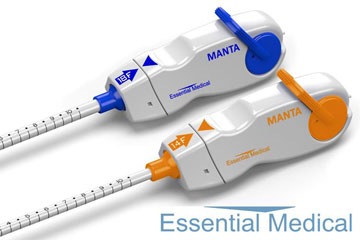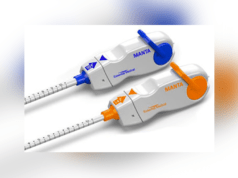
Results from the SAFE MANTA IDE clinical trial—the first pivotal trial for a dedicated large bore closure device (Manta, Essential Medical)—show haemostasis was achieved in less than one minute in 86% of the primary analysis cohort, and in less than five minutes in 94% of this cohort. Within the cohort, transcatheter aortic valve implantation (TAVI) was performed in 210 patients (79.8%) and percutaneous endovascular aneurysm repair (PEVAR) or thoracic endovascular aortic repair (TEVAR) was performed in 53 (20.2%) cases.
David Wood (Centre of Heart Valve Innovation in Vancouver, Vancouver, Canada), principal investigator, presented the results during the Late-Breaking Clinical Science Forum at the 2018 Transcatheter Valve Therapeutics (TVT) meeting (20–22 June, Chicago, USA). He reported that the SAFE MANTA trial was a prospective, single-arm study, used 20 sites with 42 operators, and had a total enrolment of 341 patients, with 263 patients in the primary analysis cohort and 78 roll-in patients.
The primary safety endpoint was incidence of IDE protocol major complications at 30 days, and the primary effectiveness endpoint was time to haemostasis. The more academically relevant Major Valve Academic Research Consortium-2 (VARC-2) Major Vascular Complications were tracked as a secondary endpoint.
The study required rigorous use of imaging at the access site, with angiography at access and closure, as well as duplex ultrasound within 48 hours of the procedure and at 30-day follow-up. Follow-up was at 30 and 60 Days. The 14Fr Manta device was used in 42 cases (16%) and the 18Fr device was used in 221 cases (84%).
VARC-2 Major Vascular Complications occurred in 11 patients (4.2%), in which four patients received a covered stent (1.5%), three patients had access site bleeding (1.1%), two underwent surgical repair (0.8%), and two underwent balloon inflation (0.8%). The mean time to haemostasis was 65±157 seconds, and median Time to haemostasis was 24 seconds. Haemostasis was achieved in less than one minute in 86% of the primary analysis cohort, and in less than five minutes in 94% of the cohort. Additionally, the technical success rate was 97.7%.
Wood comments: “Data from the IDE study is exciting, particularly the rapid time to haemostasis, and compares favourably to current published outcomes. The ease of use associated with the Manta device and the promising data collected through this trial indicates that Manta could be the answer to the complex issue of large bore vascular closure.”
The chief medical officer at Essential Medical, Gary Roubin, says: “The results from this study validate our expectations for the promise of Manta technology, of particular note is the extremely low occurrence of bleeding, which directly relates to the potential for improved clinical and cost outcomes with both TAVI and EVAR.”









